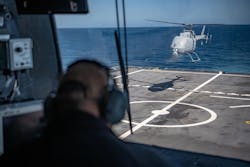Navy asks Northrop Grumman to provide cyber security intrusion protection for MQ-8C unmanned helicopter
City and state – U.S. Navy cyber security experts are asking Northrop Grumman Corp. to provide cyber-intrusion protection for the Navy-Northrop Grumman MQ-8C unmanned helicopter to prevent adversaries from taking over control of the aircraft.
Officials of the Naval Air Systems Command at Patuxent River Naval Air Station, Md., announced a $19.1 million order Tuesday to the Northrop Grumman Aeronautics Systems segment in San Diego to provide a cyber-intrusion protection system in support of the MQ-8C vertical takeoff and landing tactical unmanned air vehicle system.
The MQ-8C Fire Scout vertical take-off and landing tactical unmanned aerial vehicles (VTUAV) is based on the manned Bell 407 helicopter from Bell Helicopter Textron Inc. in Fort Worth, Texas.
The order includes non-recurring engineering, hardware qualification, systems integration, safety assessment, retrofit installation, and flight testing of the MQ-8C's payload interface unit and vehicle management computer to include a cyber-intrusion protection.
Related: Military cyber security: threats and solutions
The original MQ-8A and MQ-8B versions of the Navy Northrop Grumman Fire Scout UAV are based on the Schweizer 333 helicopter from Schweizer Aircraft Corp., now owned by Rotorcraft Services Group in Fort Worth, Texas.
The commercial version of the Schweizer 333 seats three, can carry a payload of 1,250 pounds, can fly as fast as 105 knots, and has a maximum range of 319 nautical miles. The MQ-8B is limited to operating for eight to 12 hours per day of ISR coverage at a range of 100 nautical miles, Navy officials say. To meet the longer-range requirements, Northrop Grumman experts will use the avionics developed for the MQ-8B, as well as the software and ground-control systems, on the longer-range MQ-8C Fire Scout based on the Bell 407.
The MQ-8C provides the Navy with an increased range of more than 30 percent, twice the endurance, and an increased payload capacity over the MQ-8B variant, Northrop Grumman officials say. The unmanned systems architecture developed for the MQ-8B is re-used in the Bell 407.
The primary advantage of the MQ-8C Fire Scout over its MQ-8B and MQ-8A versions is the newest shipboard UAV has double the useful payload of its predecessors. The newest model also has a somewhat faster top speed and slightly more maximum range than previous models of the Fire Scout.
Manufacturing and assembly operations of the new Fire Scout variant are at Bell's facility in Ozark, Ala., and final assembly is Northrop Grumman's Unmanned Systems Center in Moss Point, Miss.
On this order, Northrop Grumman will do the work in San Diego and Mojave, Calif., and should be finished by May 2026. For more information contact Northrop Grumman Aeronautics Systems online at www.northropgrumman.com/who-we-are/business-sectors/aeronautics-systems, , Bell Helicopter Textron at www.bellflight.com, Rotorcraft Services Group at http://rotorcraftservices.com, or Naval Air Systems Command at www.navair.navy.mil.
About the Author
John Keller
Editor-in-Chief
John Keller is the Editor-in-Chief, Military & Aerospace Electronics Magazine--provides extensive coverage and analysis of enabling electronics and optoelectronic technologies in military, space and commercial aviation applications. John has been a member of the Military & Aerospace Electronics staff since 1989 and chief editor since 1995.
